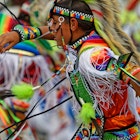
Mar 13, 2024 • 6 min read
May 8, 2020 • 4 min read

Many homes on the Navajo reservation lack running water and central heat and air, making social distancing and other pandemic protocols a challenge © Gina Ferazzi / Getty Images
Though the landscape of the ancestral Navajo lands – the colorful, arid contours of Canyon de Chelly, Shiprock, Monument Valley, and Antelope Canyon – couldn't look more different than the rolling, verdant hills of Ireland, the two countries have more in common than meets the eye.
In fact, the COVID-19 pandemic has introduced many to the nearly two-hundred-year-old history of solidarity between the Irish and Native Americans – a bond that's now helping the Navajo Nation even as it's being ravaged by the novel coronavirus.
The Navajo Nation is no stranger to hardship. Over the past two hundred years, the Diné people have survived devastating diseases, forced marches, family separations via government-run boarding schools, climate change, and more. Now, the Navajo are experiencing some of the highest rates of COVID-19 infection in the United States.
Help is, however, coming from a surprising source. This is the story of a kindness that, while a small footnote in the pages of history, has managed to span almost five thousand miles and the collective memory of generations, and now has helped a devastated community raise almost two million dollars for essential food, water, and personal protective equipment.

The Navajo Nation may be the largest Indian reservation in the United States, taking up about the same amount of land as the state of West Virginia, but its population is smaller than that of Honolulu, Hawaii. Despite being home to only 357,000, however, the COVID-19 infection rates coming out of the Navajo Nation look more like that of New York City or the whole state of New Jersey – a full ten times higher than the rest of Arizona, where much of the Navajo reservation is situated. The rampant spread of COVID-19 is exacerbated by the prevalence of chronic illnesses like diabetes and asthma, which are common, reports Reuters.

Resources – including easy access to fresh food and running water – are scarce. A high percentage of Diné people are unemployed and COVID-19 is also threatening tribal elders who are integral to the Navajo community and culture. On March 15, several community members set up a GoFundMe to raise money on behalf of the Rural Utah Project to benefit Navajo and Hopi families affected by COVID-19. The goal was to purchase PPE, food, diapers, and medicine for those in need. A month and a half later, a curious trend emerged in the comments left by donors, many with Irish surnames such as Doyle, O'Connor and McCarthy.

The small payments, $10 here or $50 there, often came with short messages like "Ireland remembers," or "170 years later, thank you from Ireland," or a simple thank you in Gaeilge, "Go raibh maith agat." Others included a photo of Alex Pentek's Kindred Spirits – a 2017 sculpture in Midleton, County Cork, made up of nine enormous eagle feathers.
One acknowledged the terrible history of disease in Indigenous history, reading, "To alleviate another virus in the Native American communities not of their making and in return for their support to Ireland to alleviate the effects of the potato virus of 1845-1847."

The answer to why so many Irish have been donating money to the Navajo goes back a hundred and eighty years. Less than a generation before, the US government had forced the Choctaw tribe to march from their homes in what is now Mississippi along the Trail of Tears to Oklahoma, where they still reside today.
Throughout the mid to late 1840s, newspaper headlines informed the world that millions of Irish were starving during the great potato famine. The plight of the Irish struck a chord with the Choctaw, who knew something themselves about hunger, being far from home, and trying to hold families together under colonial rule.

Despite their own poverty, the Choctaw gathered as much money as they could, and sent US$170 (about $5000 today) to Ireland. It was a kindness that many Irish families never forgot and forged a tight bond between Native Americans and the Irish that continues to this day. Naomi O'Leary, Europe Correspondent with the Irish Times, took to Twitter in early May to encourage fellow Irish to remember the Choctaw's gift, and donate what they could. "Native Americans raised a huge amount in famine relief for Ireland at a time when they had very little," she wrote. "It's time for [us] to come through for them now."

It wasn't the first time O'Leary has tackled the subject. O'Leary also re-shared a Twitter thread she first penned in 2017, highlighting some of the long history of solidarity between North American First Nations and Ireland. One such example was a photo of future Irish president Éamon de Valera in 1919, wearing a full war bonnet given to him by Ojibwe-Chippewa. It was a gift that commemorated his new designation as honorary chief, and "representative of one oppressed nation to another."
While much has changed in the past hundred years, one thing hasn't, at least – human kindness and compassion, even in the direst of straights.

Attraction
Coasts, Castles and Culture: Nine days on Ireland’s Wild Atlantic WayMay 20, 2024 • 12 min read

Mar 13, 2024 • 6 min read



Apr 5, 2022 • 10 min read




